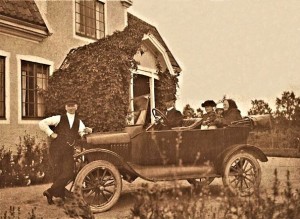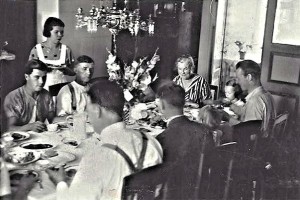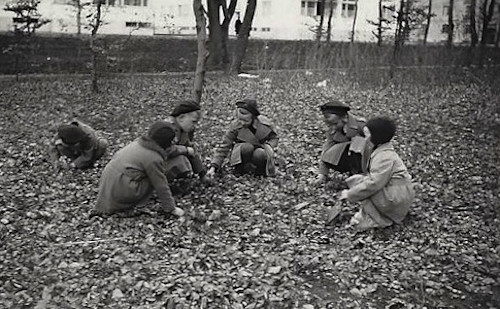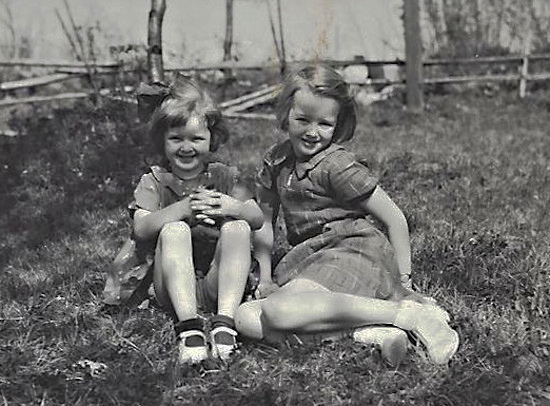Chapter 1 (Part 3) — The paradise of my childhood
It was a cold winter at the beginning of the war and we were on our way to the paradise of my childhood in southern Småland. In the city of Vaxjö we changed trains to a narrow-gauge one that ran by coal. I was thrilled and curious. Why was it so dirty? What were those blue and white bowls that were set out on the floor at regular intervals? Since the locomotive was powered by coal, the windows were closed tight. The train blew its whistle again and again, as if to show off its power and strength.
Knällsberg
It was just before Christmas and there was a lot of snow on the trees and fields. The wooden telephone poles went by like high masts against the white landscape and the telephone wires seemed to be moving up and down as I sat looking out the window at the snow. Up and down, up and down, a hallucinating sight you don’t see any more since telephone wires are now buried in the ground. And every once in a while a cloud of black soot was belched out of the engine smokestack.
The wooden benches we sat on looked quaint, but the soot got onto everything inside in spite of the closed windows. I was used to seeing upholstered seats in a train. Mother explained that the bowls on the floor were spittoons, set out with regular intervals in the long and carriage. But why would people spit indoors, we wondered. Well, they don’t any more, said Mother, but there they were anyway.
The train worked its way from Växjö to a town called Tingsryd – slowly. We must have changed trains again in Tingsryd, and I can’t remember where we finally got off this quaint old train. But when we did, there was Mother’s Uncle Julius waiting for us with a horse and a sleigh with little bells that made joyous sounds. We had never traveled by sleigh before and it was even more unforgettable than the quaint old train. First, heavy blankets were tucked around our legs against the cold and then our jingly sleigh set out on a path so narrow that the snowy branches of the pine trees on the sides almost swept against us.
This was a fairy tale. Snow, snow and snow on both sides of the sleigh and you could see the soft white cover over the ground deep into the forest on both sides. The branches of the pine trees and spruce were heavy with snow. We didn’t usually have a lot of snow in Skåne where we lived now, and to us this was exotic. The horse made snorting noises and the bells kept jingling. We were moving as through a white tunnel and we felt warm inside the blankets. We must have traveled a couple of kilometers on those little roads and it could have lasted forever as far as I was concerned. This was a dream.

Mother’s aunt’s and uncle’s farm — Knällsberg — was wonderful, filled with memories of summer hay rides, wild strawberry and blueberry picking in the big forest, and wonderful feasts in the big dining room. Especially at Christmas.
The house, which was almost like a mansion in fact, was the home for a family of ten, plus guests at this time of the year. But somehow there was room for everyone.
I remember the dining-room very clearly. It seemed huge to me and along one side of the room there was a hard but comfortable sofa that at the time seemed to me to be ten meters long. Of course it wasn’t, but it was the longest and also one of the hardest sofas I had ever seen.
Aunt Sigrid was a fabulous cook, which her sister, my grandmother, was not. Uncle Julius, who was everybody’s Uncle Julle, and my grandmother’s sister, Aunt Sigrid, were my very favorite relatives. And of course all their eight children ranging from grown-ups to adolescents.
The children ranged from about Mother’s age down to the youngest one, Ingrid, who was close to my sister Gun’s age. And how they always spoiled us! The youngest girls, Karin and Ingrid let us have their dolls’ house furniture which I kept for years and I made up my own little dolls’ house at home in Malmö.
Now it was Christmas and our Grandma and Grandpa were there too. Aunt Sigrid and her daughters had set a long table in the huge dining-room with everything you could possibly eat for a real Swedish Christmas, the big ham being the most important dish for a Swedish Christmas feast. Aunt Sigrid lavished cream and eggs on everything she cooked. I remember watching her and my eyes must have been big with amazement. She was also the most loving and generous person I have ever known. It’s very funny how my own grandmother, her sister, was so stingy that she wouldn’t use the eggs and cream and butter it takes to make good food, and so her food always came out tasting watery. So much for sisters being alike. Usually they are very different it seems to me.
There was no refrigerator in those days, certainly not in the country, but the cellar which you got to from a trap door in the kitchen floor was quite cold enough, especially in the winter. In the evenings the Christmas table (julbord) was covered with big white sheets after the meal was over, but of course all the meats were stored in the cellar before the sheets were spread.
Knällsberg was fabulous in the summer also. One clear memory that will always stay with me was one day when a cousin of Mother’s came running into the house saying “Hurry hurry you’ll see something you’ve never seen before!” We ran with him out into the stables and there in a separate little pen was a newborn foal. He had just been born and he was still lying down. As we were watching, he got up onto his thin legs for the very first time, a bit unsteady, the mother mare standing next to him. I asked if I could hold out my hand to him and they said Yes, I could. The foal licked my hand with a scratchy-feeling tongue. What a thrill. I was in heaven.

Aunt SIgrid’s two youngest sons were Arne and Stig and they would come to the woods with us to pick wild strawberries and blueberries. They made cones from birch bark to put the berries in and they were full of fun and ideas that were all new to us.
Also in the summer there were the hay rides. We would sit up on top of the horse-drawn cart on the prickly hay, and as we got to the farm, we slid down the side and a grown-up cousin, Sture or Rune, caught us in their strong arms. I had never had more fun.
One dinner in the middle of summer stands out in my memory. Aunt Sigrid came into the dining room from the kitchen with a huge flat serving dish overflowing with wild strawberries and blueberries and saying ‘My dear children I have got nothing but berries for dessert’. When talking to everybody she would always say ‘my dear children’. And of course there was heavy cream to go with the berries.
The various visits to this paradise stand out in my memory as brightly colored leaves in the book of my childhood. Whenever I came back later on, when Aunt Sigrid had become a widow and had moved to a comfortable apartment upstairs, the downstairs now being the home of the oldest son, Sten, and his family, I still felt the old flair of warmth and happiness that had always been associated with this big farm, its huge forests, the milling around of kind people, the numerous animals — life and movement everywhere. But Aunt Sigrid was never quite the same after Uncle Julle died.
War and Evacuation
Two days after Hitler’s invasion of Poland in September 1939, England and France declared war on Germany. Munich was forgotten and Chamberlain had been revealed as a fool for ever having trusted Hitler on his word. The truth was that neither England nor the United States was really opposed to the Nazi regime, which was one basic reason why Hitler got away with as much killing as he did. And nobody wanted the German Jews.
Then one day… I was six years old, kneeling on the carpet in front of the fireplace, my hands under my chin. The black headlines in the newspaper were staring at me. Mother was standing next to me talking on the telephone that was placed on the mantelpiece. Something terrible had happened. It was so frightening it couldn’t be said out loud. Mother said “Oh my God. I can’t believe it.” What, she did not say. But she was almost crying. Was this the end of games and laughter and sunlight? The long words in the newspaper were a bit difficult to make out and the black ink was frightening. I had come up from playing in the park because I’d fallen and scratched my knee. Mother was supposed to see to it and put on a band-aid, but she had forgotten that my knee was sore and she’d forgotten that I was hungry. Time had stopped and waves of fear were emanating from the telephone. And fear was coming at me from the black letters in the headlines of the newspaper.
This was the beginning of the Winter War between Russia and Finland.
She hung up and I asked her what ‘they’ had done. She said The Russians were bombing Helsinki. It was November 30, 1939. The headlines in big black letters were screaming at me. Mother said Russia wanted to secure its access to the Baltic and so this war had now started. What’s war? When people want to get what is not theirs and they just go right in and take it. Like Hitler had done in Poland a couple of months before. Then there is war.
Mother was very upset and frightened. I had of course heard the name of Hitler before. It was someone everybody feared. Mother said he was like the president of Germany. I knew that Germany was a country like Sweden and that it was on the other side of the Baltic. But it was not like Sweden. There is Hitler and he is taking over one country after the other. And now there was Russia that was the warmonger, and Stalin who was making war on Finland. Mother was trying not to show me that she was crying and I asked her if the war was going to go on for a long time. She said ‘Yes war was horrible and it might go on for a long time.’
After Christmas of 1939 there were rumors that children in Malmö, and maybe all over Skåne, were to be evacuated. Denmark and Norway had been occupied by the Nazis and the Swedish government was far from sure that Hitler didn’t also have his eyes on Sweden, mainly because of its iron mines, but also to get into Norway and into Finland where the winter war with Russia was going on. The Nazi-Soviet Non-aggression Pact had been signed – hypocritically on Hitler’s side – in August 1939 and that made Russia the enemy of the Allies too.
Swedish children collected money for Swedish volunteers in Finland, to buy warm sleeping bags and whatever they would need during that cold winter.[3. The Finnish troops fought incredibly bravely and, to begin with, they were very successful along the 1000 km long border with Russia. The Finnish soldiers on skis fought a guerilla-like war on the Soviet troops who were not well prepared for the massive snow and cold, their heavy tanks getting bogged down in the masses of often muddy snow. However, ultimately the Russian troops proved to be superior in number and equipment and when the fighting centered in on the Karelia isthmus, the Soviet troops broke through the so-called Mannerheim line and the Finnish government had to sign a harsh peace treaty in Moscow on March 13, 1940, losing almost all of the Karelia isthmus, which is still Russian territory.]

My sister Gun collected money for the Swedish volunteers and once she got mentioned on the weekly children’s radio program, every Thursday at 5. It was run by the inimitable Sven Jerring who was all Swedish children’s Uncle Sven. The program was called the Children’s Mailbox (Barnens brevlåda) and Uncle Sven (farbror Sven) received children who sang, read their poems or told stories, and in the end he read letters from sick children in hospitals all over Sweden.[4. Bqrnens brevlåda was an extraordinarily popular program for children which was broadcast from 1925 to 1972. Sven Jerring got to be known to the entire Swedish people as farbror Sven.] It was an excellent program and Swedish children were all glued to their radios at 5 every Thursday afternoon. We would be out playing in the park in front of our apartment building, but when 5 o’clock approached we would all run to one or another of our apartments.
I remember well one afternoon when all the kids were sitting or lying on the floor in front of the radio in our living room. I remember how Uncle Sven would praise the children who didn’t sing too well even more than those who did. It was 1939 and families had one radio, not multiple radios all over. So one Thursday afternoon in December that year Uncle Sven read my sister’s name and thanked her for having collected all that money for the Swedish volunteers in the Finnish winter war against Russia. I felt so proud of her. “We thank Gun Molin in Malmö” said Uncle Sven. She also got a pretty certificate thanking her. We actually had a family friend, Gösta Klinglund, who was then a volunteer in Finland, or who was going to leave shortly, and that had clearly spurred Gun to do the collection of money in our apartment building. He came back safely when the Winter War was over. It was a fierce war though and the Finns managed to hold off the Russians mainly because they were on skis around the border and the Russian tanks were sinking into the mud they themselves had created. It actually turned out to be a guerilla war. England had been extremely close to declaring war on Russia too, which would have been a disaster. It was Winston Churchill, then a very secondary figure in the Royal Navy, who made the British government understand at the very last moment that it would have been madness. A British fleet was already on its way to Narvik, the port city in northern Norway, but it was called back and a calamity was avoided.
At the beginning of the war, the British bombers on their way to attack Hamburg would fly over Denmark and Malmö. We had a total blackout, heavy black paper in all windows in Malmö at the time. I’ll never forget the search lights that crisscrossed over the sky on most dark evenings. However, a British bomber, possibly still seeing some lights and believing it was Hamburg, by mistake dropped a bomb over Malmö. It landed without any real harm done in one of the big parks, the one called Slottsparken, but it did make quite a crater of course. To begin with nobody really knew, not officially at least, where the bomb came from. Was it the German Luftwaffe on their way to London or was it the British Air Force on their way to Hamburg?
I wrote a newspaper that was made up of four small pages folded and stapled together. There was a front page article about a big bomb that had been dropped in Slottsparken and how it had made ‘a deep hole in the ground’. I was thinking that the sky carried lead. Heavy bombs were like lead. Bombs were death falling haphazardly on whatever happened to be in their way. You happened to be there – you were dead. Death became something very real even to us children when we understood that it could happen to us. Basically though, we felt safe because we knew that Sweden was not at war with Germany. As Mother said, Sweden, Switzerland and Spain were not in the war. She did not mention that Spain just emerged from a most cruel civil war, where the German Luftwaffe had heavily supported the fascist General Franco.
Mother kept the newspaper I wrote and I remember the big printed letters scrawled over the pages mentioning the big hole that I never saw. Grown-ups were talking about the event, perplexed and worried. I somehow understood that it was believed to have been an English bomber that had mistaken Malmö for Hamburg or some other city in Germany. They said since Malmö was totally darkened because of the war, there was little difference between it and an also darkened city in Germany. I thought to myself that it was really a careless way of conducting a war if you weren’t even sure of where you dropped death.
________________
Mother had the wonderful idea of organizing an evacuation camp of her own. Mother often had the greatest ideas and we adored her. She put in an ad in the local newspaper, Sydsvenska Dagbladet, and made it known that she was opening a private evacuation camp in northern Småland in a mansion, Gärahov, that Mother had rented. It was situated not far from Vaggeryd where we had formerly been living. She got several answers and the parents were all told to put name tags in their child’s clothes. She closed her Mohlins Foto atelier on Gustav Adolfs Torg (Plaza) for a semester or more, and we all went to northern Småland, Gärahovs Herrgård. I remember a couple of the children still today, and Gösta Klinglund’s young daughter, who was about my age, was among them. This was in the spring and summer of 1940.
We spent a wonderful spring semester and the summer in the peace of a mansion in beautiful northern Småland with pine and birch forests, while the war was heating up on various fronts in Europe. Mother had assured the help of at least one woman friend from Vaggeryd and the running of the camp went very smoothly. Gun went by bike to our former school in Vaggeryd, a private boarding school where we both went when we lived in Vaggeryd — Gun in first grade, I in kindergarten. I turned 7 that spring and in Sweden we start school at that age, so II had no school obligation for this spring semester.
Intermezzo
The lake where we went swimming was a fair distance away from the manor house . We had to walk through the pine forest that was part sun part shade and that smelled of summer warm pine needles. Under the carpet of needles there was the sandy soil. I was sitting on a big tree root digging my toes into the warm soil wondering where the pungent smell was coming from. Gun came up to me, so I must have run ahead. It seemed that it must be worms in the soil that I was digging up with my toes, and I was trying to find out what it might come from. The sun was slanting down through the pine trees and there was a warm and timeless odor of resin and sun-warmed pine needles. Slowly moving heat waves in the half-shade under the giant trees. We were on our way down to the lake and waiting for the others to catch up.
One early and sunny morning when Gun and I were out early in the morning looking for wildflowers for Mother’s birthday, June 7. We saw oodles of backsippor (pulsatilla vulgaris) on a sunny green hillside. We might well have been looking for for lilies of the valley since they were Mother’s favorite flowers. But I can still see the deep purple pulsatilla spotting the hillside. I love those timid little downy flowers, and I have managed to plant some in the long flower patch we have in our front yard here in Genas. They pop up every spring with their downy little heads and when they open up, their heads are always bent over, as if they were timid.
On this early June morning we brought back two pretty bouquets of wild flowers to Mother, one each, but I am quite sure that Gun’s was more orderly than mine. There were no pulsatilla in either one of our bunches of flowers, since their stems are too short for a birthday bouquet.
Later on, this spring and summer would be like a wonderful dream. It seemed like eternal sunshine with occasional and sudden summer showers. I remember clearly one sudden shower when we ran around on the big lawn in bathing suits holding huge wheels of Swedish knäckebröd (crisp bread) on our heads like umbrellas. Laughing happily as the bombs were raining on Europe.
Continued: Chapter Two – Malmö and Copenhagen
